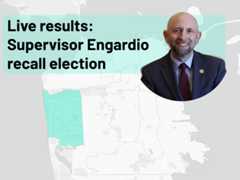It was cheaper to oust Joel Engardio than to elect him, data shows
Share this:
- Click to share on X (Opens in new window)X
- Click to share on Facebook (Opens in new window)Facebook
- Click to share on Reddit (Opens in new window)Reddit
- Click to share on WhatsApp (Opens in new window)WhatsApp
- Click to email a link to a friend (Opens in new window)Email
- Click to print (Opens in new window)Print


Sign up below to get Mission Local’sfree newsletter, a daily digest of news you won’t find elsewhere.
The anti-recall effort was a lot of things, but it wasn’t cost-effective.
Despite raising three times the money of the recallers, last week63 percent of District 4 voters decided torecall Supervisor Joel Engardio.
And, while “it’s always easier to be against something than to be for something,” as political strategist David Ho put it, it turns out it was much, muchcheaper to be against Engardio, too.
The recall supporters spent just $368,180 to get rid of Engardio, $124,658 less than it took to elect him in the first place, back in 2022. That spend — $27.61 per vote — was also about a quarter of what the anti-recall side spent per vote failing to convince voters to keep Engardio on.
“The money didn’t matter at that point: It had shifted from a political campaign to a movement,” said Jim Ross, a veteran political consultant. “No amount of money could have stopped that.”
The recall was successful in part because Engardio had alienated his base by championing Prop. K to close the Great Highway, and that created an angry and energized electorate — a movement.
“You don’t need millions of dollars to run a district campaign,” said Eric Jaye, a political consultant. “The energy you need can easily be generated if the underlying issue is vital enough to people in that district.”
To that point, this recall’s smashing success makes it all the more likely thatmore recalls could happen.
“Without a doubt, it’s a message to every elected official in San Francisco: You can ignore the will of the voters, but you do so at your own peril,” said Jaye.
Here are some data takeaways from the recall election results.
1. Recall campaign spent 1/4 as much per vote as Engardio did
The anti-recall campaign spent $105.16 per vote, whereas the recall campaign spent just $27.16 per vote.
That $105.16 outlay was driven by a handful of wealthy tech donors, including Chris Larsen (who contributed $200,000), Jeremy Stoppelman (who contributed $175,000) and John Wolthius (who contributed $100,000). Those big donations bolstered the anti-recall efforts.
Overall, the anti-recall campaign raised a total of $829,099, whereas the recall camp relied on smaller donations and gathered a total of $257,090.
What the recall campaign lacked in money, it made up for in volunteers and field operations. Even on election day, the recall side had far more volunteersgetting out the vote across the district.
The anti-recall campaign chose not to put people into the field after a pre-dawn literature drop, leaving Engardio to knock on doors on his own.
Likewise, the 2022 campaign to elect Engardio ran a higher bill than the recall: about $36 per vote. Still, around the same number of people voted for Engardio as did for the recall. In 2022, 13,643 people ranked Engardio as their first choice; this year, 13,332 supported the recall.
That’s despite District 4 turnout being higher in 2022, at 50.80 percent for the supervisor race. For the 2025 recall, only 42.2 percent of the electorate turned out.
2. A majority of voters in every single District 4 precinct voted to oust Engardio
When the Department of Elections published the preliminary recall election results at 8:45 p.m. last Tuesday, they were decisive. Even with 27 percent of the ballots outstanding, there wasn’t a statistical chance Engardio could make up the difference.
In every precinct, at least 50 percent of voters supported the recall.
3.Almost as many D4 voters supported the recall as supported Prop. K
In November 2024, 13,360 District 4 voters voted for Prop. K (23,480 voted against it).
In 2025, 13,332 voters opted to oust Engardio.
But the key factor here, once again, is wildly variant turnout. In November last year, overall turnout reached 74.2 percent, whereas for the recall election, it was only 42.2 percent.
4.The precincts that most supported the recall were Engardio’s home base
The precincts spanning Lakeshore and Merced Manor, the southernmost areas of the district, were the most supportive of the recall. In one of them, a whopping 80 percent of voters supported the recall.
Those precincts also happen to represent Engardio’s home base — and the precincts that got him elected in the first place. Those precincts were grafted into District 4 when the city’s political map wasredistricted in 2022. So was Engardio; he lives there.
Correction: We’ve updated the totals in this piece to reflect money spent rather than money raised.
We're more than halfway there!
We've raised 2/3 of our$300,000 goal to cover immigration for thenext three years of Trump's term! More than 500 of you have stepped up since September — an incredible feat of community support.
We are humbled. We still have a bit to go: Donate below if you want to keep Mission Local in the courts, reporting on ICE's actions in San Francisco.



